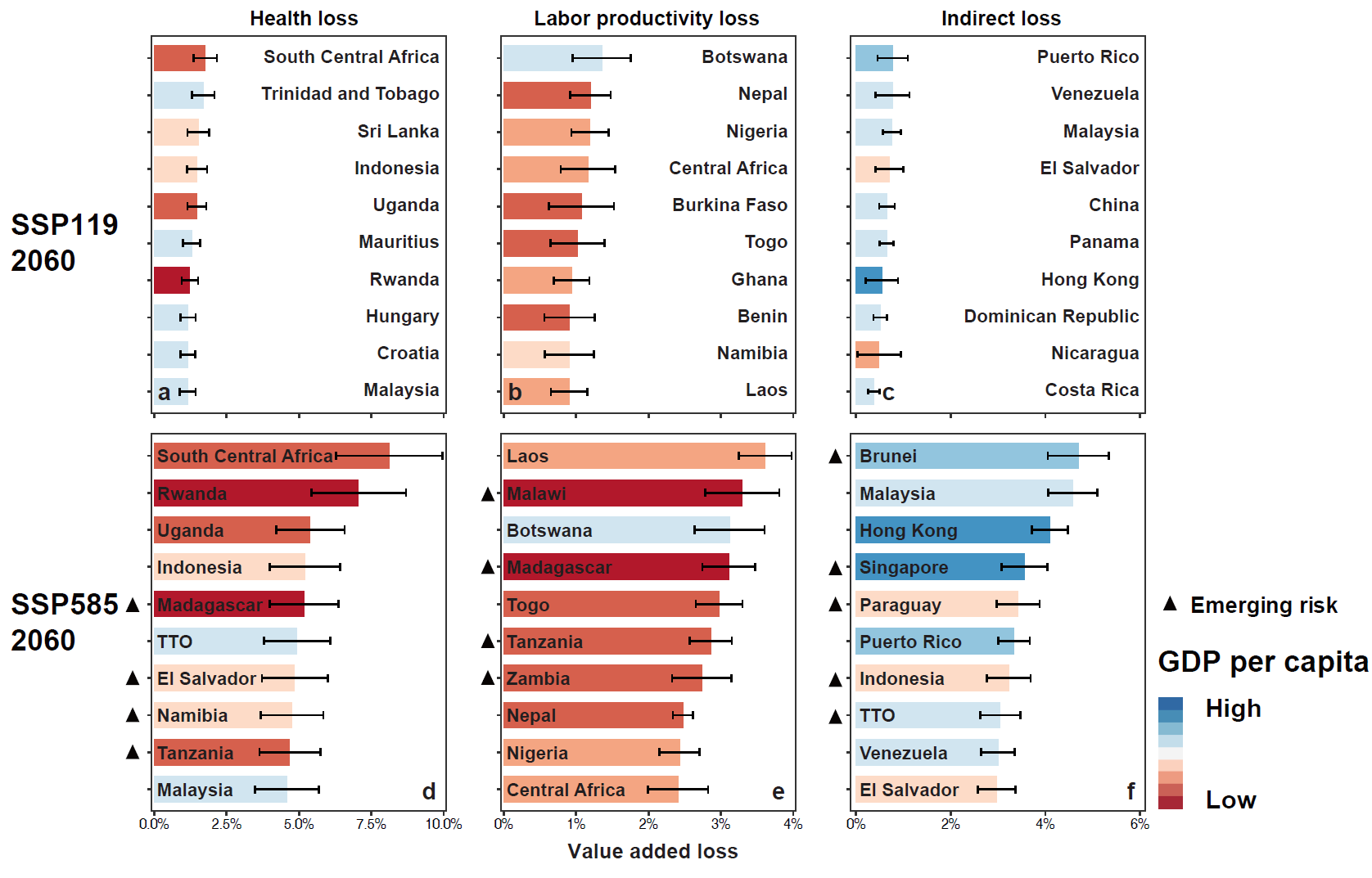![]()

![]()
Global GDP loss from climate change will increase exponentially the warmer the planet gets when its cascading impact on global supply chains is factored in, finds a new study led by researchers of Tsinghua University.
The study, published in Nature, is the first to chart “indirect economic losses” from climate change on global supply chains (GVCs) that will affect regions that would have been less affected by projected warming temperatures. These previously unquantified disruptions in supply chains will further exacerbate projected economic losses due to climate change, bringing a projected net economic loss of between $3.75 trillion and $24.70 trillion in adjusted 2020 dollars by 2060, depending on how much carbon dioxide the gets emitted. The expected economic losses across three projected global warming scenarios are compared, called “Shared Socioeconomic Pathways” or SSPs, based on low, medium and high projected global emissions levels.
Senior Author Professor Dabo Guan said: “These projected economic impacts are staggering. These losses get worse the more the planet warms, and when you factor in the effects on global supply chains it shows how everywhere is at economic risk.”

Figure 1 Global heat-related losses in the midcentury and their distributions across the world.
As the global economy has grown more interconnected, disruptions in one part of the world have knock-on effects elsewhere in the world, sometimes in unexpected ways. Crop failures, labour slowdowns and other economic disruptions in one part of the world can affect the supplies of raw materials flowing to other parts of the world that depend on them, disrupting manufacturing and trade in faraway regions. Manufacturing heavy countries such as China incur soaring indirect economic losses of 2.7±0.7% of GDP in 2060 under the high-emission scenario. The key industrial sectors with the highest losses are extractive industries, construction and non-metallic manufacturing, etc., accounting for about 4.6% to 6.4% of industry value added.
The direct human cost is likewise significant. Even under the lowest path, 2060 will see 24% more days of extreme heatwaves and an additional 590,000 heatwave deaths annually, while under the highest path 104% more heatwaves and an expected 1.12 million additional annual heatwave deaths. While tragic on their own, this human toll entails economic costs as well, such as increased healthcare costs and production losses stemming from lost labour. These impacts will not be evenly distributed around the world, but count countries situated near to the equator will bear the brunt of climate change, particularly developing countries.

Figure 2 Top ten regions with the severest losses by type under SSP 119 and SSP 585 scenarios
“Developing countries suffer disproportionate economic losses compared to their carbon emissions”, said Yida Sun, co-lead author of this research from Tsinghua University, “It is affected by multiple and complex factors such as the climatic zone, industrial structure and position in GVCs”. A machine learning approach reveals heterogeneous climate risk patterns across countries globally, providing insights for targeted climate risk resilience enhancement, especially for low-income developing countries.
Professor Guan remarked: “Negative impacts of extreme heat sometimes occur quietly on global supply chains, even escaping our notice altogether. Our developed Disaster Footprint model tracks and visually represents these impacts, underlining the imperative for global collaborative efforts in adapting to extreme heat.”
For example, although extreme heat events occur more often in low-latitude countries, high-latitude regions, such as Europe or the United States, are also at significant risk. Future extreme heat would be expected to cost Europe and the US 2.2±0.7% and 3.5±1.3% of GDP separately under the high emission scenario. The UK would lose 1.5±0.5% of its GDP, with chemical products, tourism and electrical equipment industries suffering the most losses. Some of these losses originate from supply chain fluctuations induced by extreme heat in low-latitude countries. Global collaboration in adapting to extreme heat plays an important role in the efficient operation of global supply chains, which means that everyone will benefit from collaboration, whether in low latitudes or high latitudes.

Figure 3 Top five industrial sectors with the most severe heat-related losses in four representative countries.
Professor Guan said: “This research is an important reminder that preventing every additional degree of climate change is critical. Understanding what nations and industries are most vulnerable is crucial for devising effective and targeted adaption strategies.”
This research was supported by the National Natural Science Foundation of China and Zhejiang University.
Editor: Guo Lili
